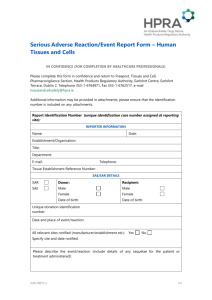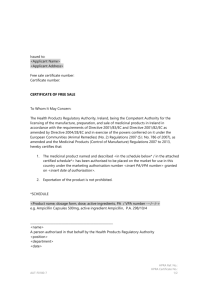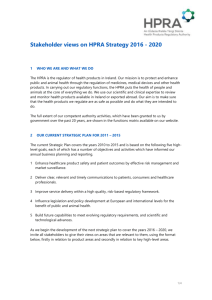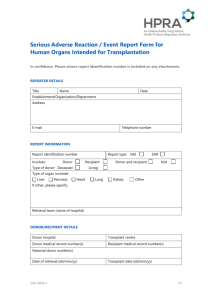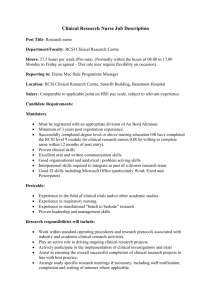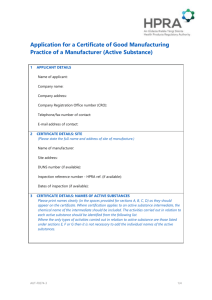Serious adverse reaction (SAR) - The Health Products Regulatory
advertisement
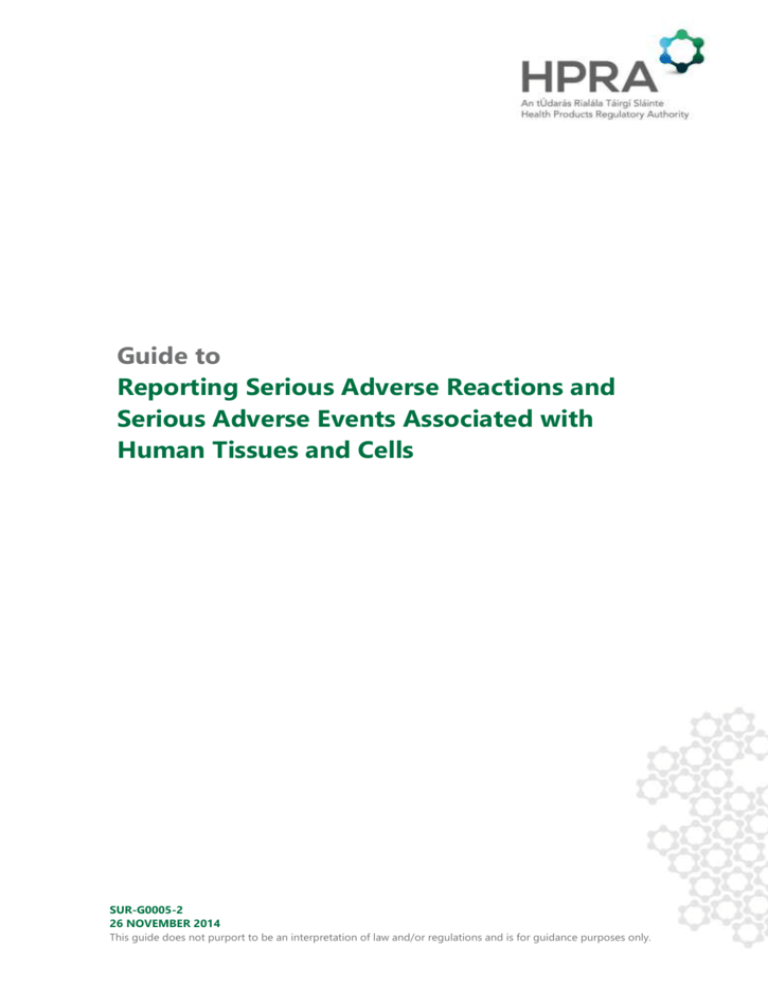
Guide to Reporting Serious Adverse Reactions and Serious Adverse Events Associated with Human Tissues and Cells SUR-G0005-2 26 NOVEMBER 2014 This guide does not purport to be an interpretation of law and/or regulations and is for guidance purposes only. HPRA Guide to reporting Serious Adverse Reactions and Serious Adverse Events associated with Human Tissues and Cells 1 INTRODUCTION The following document is intended to provide guidance for tissue establishments and/or other relevant organisations on the procedure to follow for submission of a suspected serious adverse reaction (SAR) or serious adverse event (SAE) report to the Health Products Regulatory Authority (HPRA). The HPRA has been designated as the national Competent Authority for the purpose of implementing EU and national legislation related to human tissues and cells, including the following: - Directive 2004/23/EC of the European Parliament and of the Council of 3 March 2004 on setting the standards of quality and safety for the donation, procurement, testing, processing, preservation, storage and distribution of human tissues and cells. - Directive 2006/17/EC of the 8 February 2006 implementing Directive 2004/23/EC of the European Parliament and the Council as regards certain technical requirements for the donation, procurement and testing of human tissues and cells. - Directive 2006/86/EC of the 24 October 2006 implementing Directive 2004/23/EC of the European Parliament and of the Council as regards traceability requirements, notification of serious adverse reactions and events and certain technical requirements for the coding, processing, preservation, storage and distribution of human tissues and cells. - S.I. No. 158 of 2006, European Communities (Quality and Safety of Human Tissues and Cells) Regulations 2006. - S.I. No. 598 of 2007, European Communities (Human Tissues and Cells) Traceability Requirements, Notification of Serious Adverse Reactions and Events and Certain Technical Requirements) Regulations 2007 In accordance with this legislation, the HPRA is obliged to establish a reporting system for the notification of SARs and SAEs as outlined below. The tissue establishment is obliged to notify and provide the HPRA with a report analysing the cause of and ensuing outcome of SARs and SAEs as outlined below. It is important to note that under the legislative requirements, a procurement organisation or organisation responsible for human application is not precluded from also notifying the competent authority if it so wishes (refer to section 4). 2 DEFINITIONS (FROM DIRECTIVE 2004/23/EC) Serious adverse reaction (SAR) A serious adverse reaction (SAR) is defined as: ‘An unintended response, including a communicable disease, in the donor or in the recipient associated with the procurement or human application of tissues and cells that is fatal, life-threatening, disabling, incapacitating or which results in, or prolongs hospitalisation or morbidity’. SUR-G0005-2 2/10 HPRA Guide to reporting Serious Adverse Reactions and Serious Adverse Events associated with Human Tissues and Cells Serious adverse event (SAE) A serious adverse event (SAE) is defined as: ‘Any untoward occurrence associated with the procurement, testing, processing, storage or distribution of tissue and cells that might lead to the transmission of a communicable disease, to death or life-threatening, disabling or incapacitating conditions for patients or which might result in, or prolong, hospitalisation or morbidity’. 3 REPORTING SARS AND SAES TO THE HPRA Each tissue establishment should designate a responsible person with responsibility for ensuring that human tissues and cells intended for human application comply with the terms of the legislation. Tissue establishments, through the responsible person (or designee), are responsible for notifying and providing the HPRA with a report analysing the cause and ensuing outcome of: - any SAR or SAE which may influence the quality and safety of tissues and cells and which may be attributed to the procurement, testing, processing, preservation, storage and distribution of tissues and cells. (This includes ‘near miss’ reports where the event was detected prior to transplantation.) - any SARs observed during or after clinical application which may be linked to the quality and safety of tissues and cells. In the case of assisted reproduction, any type of gamete or embryo misidentification or mixup is considered to be a SAE and should be notified to the HPRA. 3.1 General SARs The following SARs should be reported: - - 3.2 Transmitted bacterial infection Transmitted viral infection Transmitted parasitical infection Transmitted malignant disease Other transmitted disease (e.g. immunological and genetic disease transmission) Other adverse reactions (e.g. allergy/hypersensitivity, cardiovascular, pulmonary, renal, neurological toxicity). Donor reactions Donor reactions which have no potential impact on the quality and safety of the tissues and cells fall outside the strict interpretation of the legislation. However, the European Commission recognises the value of such reports and encourages inclusion of such in the annual reports collated and submitted by CAs. The HPRA requests TEs to voluntarily submit any such reports of SARs in donors. SUR-G0005-2 3/10 HPRA Guide to reporting Serious Adverse Reactions and Serious Adverse Events associated with Human Tissues and Cells The types of donor reactions that most commonly require reporting are reactions associated with granulocyte colony-stimulating factor, calcium toxicity associated with peripheral blood stem cell collection, ovarian hyperstimulation syndrome or ‘other’ types of donor reactions resulting in harm, requiring additional medical intervention, or hospitalisation of a donor. 3.3 SARs specific to Assisted Reproductive Technology 3.3.1 Transmission of genetic disease The birth of a child in Ireland with a genetic disease following the use of non-partner gametes or embryos should be reported to the HPRA and to the supplying tissue establishment as a suspected SAR. An investigation to establish if this is considered an inherited/possible inherited condition which could be associated with the non-partner donor should be undertaken. In relation to the transmission of genetic diseases following the use of non-partner gametes, where appropriate, the HPRA will liaise with other CAs to support communication of notifications to TEs in Ireland supplied with tissues and cells from the associated donor. This highlights the importance of prompt notification of SAR/Es to the HPRA. 3.3.2 Ovarian Hyperstimulation Syndrome All cases of severe ovarian hyperstimulation syndrome and all cases that require hospitalisation should be reported as donor reactions. Information regarding the circumstances (e.g. if occurring in a non-partner oocyte donor, or in a patient undergoing IVF treatment themselves) and the time of occurrence (e.g. prior to or after embryo transfer) should be included in the report. The Guidance on Vigilance and Surveillance in ART in the EU developed by the SOHO V&S project provides guidance and references for the classification of ovarian hyperstimulation syndrome and should be followed for this purpose. As such reports involve the use of medicinal products, the HPRA will liaise internally with pharmacovigilance colleagues to review and follow up on relevant cases, as appropriate. Donor reaction reports submitted relating to ovarian hyperstimulation syndrome should include details of the medicinal product concerned, including information on the product/brand name, dose, route of administration and therapy dates. 3.4 General SAEs Any incident which has implications or potential implications for the quality and safety of tissues and cells should be considered reportable as an SAE to the HPRA. Examples of such include but are not limited to: - the distribution of inappropriate tissues/cells for clinical use, even if not used SUR-G0005-2 4/10 HPRA Guide to reporting Serious Adverse Reactions and Serious Adverse Events associated with Human Tissues and Cells - an event which could have implications for other patients or donors because of shared practices, services, supplies or donors an event which resulted in the loss of any irreplaceable autologous tissues or cells, or any highly matched (i.e. recipient specific) allogeneic tissues or cells an event which resulted in the loss of a significant quantity of unmatched allogeneic tissues or cells. 3.5 SAEs specific to assistive reproductive technology Examples of SAEs specific to assistive reproductive technology include, but are not limited to: - the release of inappropriate gametes, embryos or germinal tissues for clinical use, even if not used - an event which could have implications for other patients or donors because of shared practices, services, supplies, critical equipment or donors - an event which resulted in a mix-up of gametes or embryos - an event which resulted in a loss of traceability of gametes or embryos - contamination or cross contamination - accidental loss of gametes, embryos, germinal tissues (e.g. break-down of incubators, accidental discard, manipulation errors) resulting in a total loss of chance of pregnancy for one cycle. Please note that any loss of gametes, embryos or germinal tissue should be reported to the HPRA. Following assessment, the HPRA will decide if the case is to be included in the annual report for submission to the European Commission. The reporter will be informed of the final case classification. 3.5.1 Donor block notifications Where a risk or potential risk has been identified following the use of a non-partner donor e.g. regarding the birth of a child elsewhere with a genetic disease, inherited or possibly inherited from the donor, the supplying tissue establishment must inform all TEs who have received the associated product. The supplying tissue establishment should confirm if a donor block has been applied, and confirm the type of block e.g. temporary or permanent / conditional. The conditions of further use of the implicated donor following the performance of a risk assessment should be included. All permanent/conditional donor block notifications should be submitted to the HPRA as an SAE report. In these cases, confirmation of the tissues and cells supplied, used, stock remaining in storage and information on any offspring or ongoing pregnancies which have resulted from the use of the donor, should be included in such reports. The supplying tissue establishment should provide a risk analysis and conditions for future use, e.g. restricted to sibling creation and only after informed consent. Cases should be appropriately investigated and followed up, including relevant communication with client/s particularly where offspring or an ongoing pregnancy has resulted from the use of the donor. SUR-G0005-2 5/10 HPRA Guide to reporting Serious Adverse Reactions and Serious Adverse Events associated with Human Tissues and Cells Temporary donor blocks are not reportable to the HPRA as SAEs, but should be managed appropriately e.g. by recording details of the associated product used, information on any remaining tissues and cells in storage and confirmation that further treatment with the nonpartner gametes has been stopped until the results of any impending investigation have been confirmed i.e. the donor block is lifted or a conditional block/permanent block is applied. Where offspring or an ongoing pregnancy has resulted from the use of the donor, communication with the client/s should be managed appropriately. Where appropriate, the HPRA will liaise with other competent authorities to support communication of donor block notifications to all tissue establishments in Ireland supplied with tissues and cells from the associated donor. This highlights the importance of prompt notification of SAR/Es to the HPRA. 4 TISSUE ESTABLISHMENT REPORTING Directive 2006/86/EC recognises the central role of the tissue establishment in SAR/SAE reporting and investigation, particularly as this may involve quarantine, recall or look back for patients who have received implicated tissues and cells. Procurement organisations or organisations responsible for human applications should report SAR/Es that have occurred at their facility to the associated TE. The responsible person (or designee) at the tissue establishment is then responsible for subsequent submission of relevant reports to the HPRA. Ideally, reports should only be submitted by a tissue establishment to avoid duplicate reporting, however, reports received by the HPRA directly from a procurement organisation or an organisation responsible for human application will also be accepted. In such cases, it remains the responsibility of the reporting organisation to inform the relevant tissue establishment of the incident and to share the local/HPRA assigned case reference numbers to facilitate report linkage. Commission Annual report HPRA (Competent authority) HPRA SAR / SAE form Tissue establishment Procurement organisation SUR-G0005-2 Organisation responsible for human application 6/10 HPRA Guide to reporting Serious Adverse Reactions and Serious Adverse Events associated with Human Tissues and Cells 5 POINTS TO NOTE If there is doubt as to whether an event or reaction is reportable, it is preferable that it is reported. The HPRA will provide feedback if the case is considered to fall outside the remit for reporting and will outline the associated rationale. The HPRA may also be contacted by e-mail for queries in relation to the reporting of SAR/SAEs using the details in section 6 below. All reports should be submitted as soon as possible, providing the most complete case information available at the time of reporting. It is appreciated that follow up actions, e.g. corrective and preventative actions, may be undertaken in parallel and that information on the outcome of these actions may be incomplete at the time of initial reporting. In such cases, this additional information may be provided at a later date to ensure timely notification of reports and to subsequently support case closure. 6 INSTRUCTIONS FOR COMPLETION AND SUBMISSION OF FORMS How to report: - By using the online form, accessible from the HPRA website, www.hpra.ie. - By downloading a copy of the report form available via the Blood Tissues and Organs section of the HPRA website. Completed forms should be e-mailed to tissueandcellsafety@hpra.ie. - By printing a copy of the report form and posting a completed copy to the HPRA by freepost to the following address: Tissue and Cells, Pharmacovigilance Section, Freepost Health Products Regulatory Authority Kevin O’Malley House, Earlsfort Centre, Earslfort Terrace, Dublin 2. Copies of the form are also available on request by phone/fax/post/e-mail from the HPRA at: Fax No: +353-1-6762517 Phone No: +353-1-6764971 (ask for the Pharmacovigilance Section) E-mail: tissueandcellsafety@hpra.ie All available information should be included on the report form. - If information requested is not available, the term N/A or the words ‘not available’ should be included, where appropriate. - Supplementary information may be appended with the initial report form for clarification if considered relevant/deemed necessary by the reporter. Supplementary information may also be sent to tissueandcellsafety@hpra.ie (please ensure the report ID number is SUR-G0005-2 7/10 HPRA Guide to reporting Serious Adverse Reactions and Serious Adverse Events associated with Human Tissues and Cells included on all documentation provided, see below) - A contact name, telephone number and e-mail address must be provided to facilitate the - HPRA to follow up cases, as appropriate. All reports should be dated (note that reports submitted online will receive an automatic date-stamp). Provision of the reporter details and contact e-mail address facilitates confirmation of case closure or a request for further information, along with the provision of the unique case reference report number assigned at the HPRA (HPRA case reference number), which also serves as a confirmation of a successfully submitted report. For online reports, once submitted, a hyperlink is provided which allows a PDF of the report to be generated as a record. A PDF of the report is also attached to the automatic acknowledgement e-mail. 6.1 Completion of the SAR/E form All available information should be included on the report form. - If information requested is not available, the term N/A or the words ‘not available’ should be included, where appropriate. - Supplementary information may be appended with the initial report form for clarification if - considered relevant/deemed necessary by the reporter. Supplementary information may also be sent to tissueandcellsafety@hpra.ie (please ensure the report ID number is included on all documentation provided, see below) A contact name, telephone number and e-mail address must be provided to facilitate the HPRA to follow up cases, as appropriate. All reports should be dated (note that reports submitted online will receive an automatic date-stamp). Provision of the reporter details and contact e-mail address facilitates confirmation of case closure or a request for further information by the HPRA. Confirmation of a successfully submitted report occurs by the provision of a HPRA case reference number. 6.1.1 Report identification number (assigned at reporting site) The person submitting the SAR/SAE report should assign a local unique report identification number, which may be used to link information back to the case and to support traceability. The responsibility for assigning a system of numbering rests with the individual tissue establishment or organisation, as long as it allows for traceability and record linkage. Alternatively, a hospital or patient record number may be used. This number will be kept on file at the HPRA for future reference. SUR-G0005-2 8/10 HPRA Guide to reporting Serious Adverse Reactions and Serious Adverse Events associated with Human Tissues and Cells 6.1.2 HPRA case reference number Individual case reference numbers will also be allocated by the HPRA (i.e. the HPRA case reference number) for reference purposes and the reporting organisation will be informed of this number in any relevant correspondence. 6.1.3 Classification of events/reactions Only one box should be ticked, indicating whether the report refers to an SAR or SAE. Please note that if a reaction occurs as a result of an event, it should be considered as a reaction and reported as such, with relevant background information provided. 6.1.4 Donor/recipient information This information should be provided if known. If unknown, please state this on the form. Donor, recipient or staff names are not required and may be anonymised. Details should be provided under SAR/SAE sections of the form. 6.1.5 Dates All relevant dates should be included, please indicate if not available. 6.1.6 Unique Donation Identification Number A single identifying code should be allocated to all donated material by the tissue establishment. This code should incorporate at least the information set out in Annex VII Directive 2006/86/EC. 6.1.7 Notification of relevant establishments/site manufacturers Procurement organisations or organisations responsible for human application should have procedures in place to notify the associated tissue establishment or other relevant parties. Tissue establishments should notify other associated tissue establishments or organisations as appropriate. Information on parties notified should be included in the report. Details should be provided under the SAR/SAE sections of the form. 6.1.8 Implicated tissues and cells The implicated tissues and cells should be selected. A separate section is provided for assistive reproductive technology and Non-assistive reproductive technology rissues and cells. Please indicate if the tissues and cells are autologous or allogeneic, or in the case of ART, whether partner or non-partner treatment is involved. 6.1.9 Categorisation of SAE The following categories are provided in Annex V, part B of Directive 2006/86/EC Deviation occurring at: - Procurement - Testing - Transport - Processing - Storage SUR-G0005-2 9/10 HPRA Guide to reporting Serious Adverse Reactions and Serious Adverse Events associated with Human Tissues and Cells - Distribution - Materials - Other (specify) Specification of SAE: - Tissues and cells defect - Equipment failure - Human error - Other (specify) 6.1.10 Categorisation of SARs Provide the final clinical outcome if known. See section 3 for further information on the list of reactions. 6.1.11 Risk analysis Details of the root cause analysis and any corrective and preventative actions taken should be provided, however this information may be provided at a later date if not available at the time of the initial report. 7 PROCESSING OF REPORTS AT THE HPRA On receipt of report forms, the HPRA will: - enter anonymised information provided onto the HPRA database and assign a unique HPRA case reference number to the case. Both this number and the reference number assigned by the tissue establishment or other reporting organisation will be referenced in all correspondence. - review the data provided and consider the status of the report, any need for follow up and/or additional information to facilitate case report completion. - follow up with the reporting establishment as necessary. On completion of assessment and review of all relevant data, the HPRA will close the case and send an e-mail to this effect along with the case classification. It is important to note that although a case may have been closed, it may be revisited on the basis of further follow up information or issues arising with the report(s) or associated reports. 8 ANNUAL NOTIFICATION TO THE EUROPEAN COMMISSION On an annual basis the HPRA will submit a report, collating national information relating to adverse reactions and events to the European Commission. SUR-G0005-2 10/10
